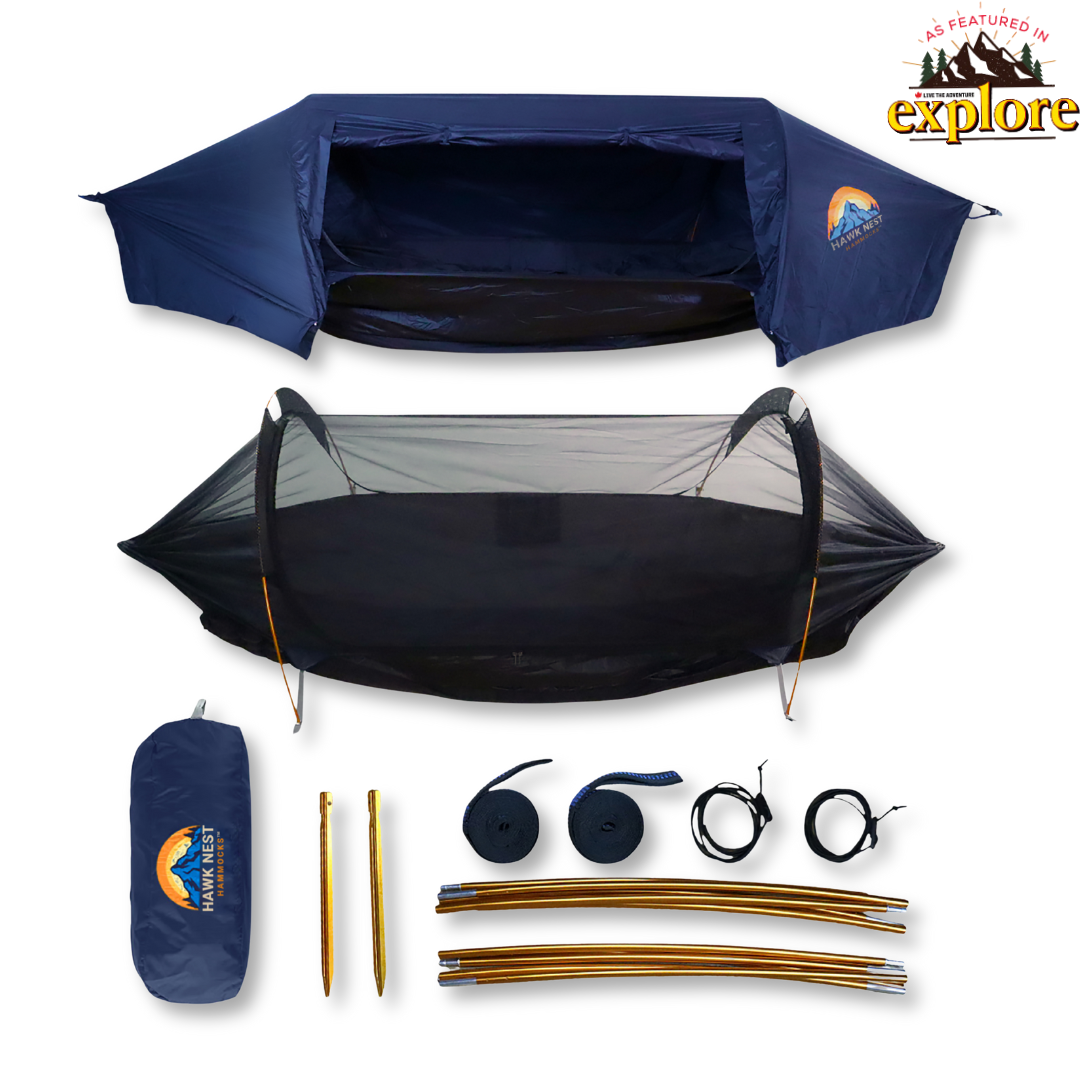Table of Contents
- Introduction to Hammock Tents for Emergency Shelter
- Benefits of Using a Hammock Tent in Emergencies
- Choosing the Right Hammock Tent for Emergency Situations
- How to Set Up Your Hammock Tent for Emergency Shelter
- Frequently Asked Questions
Introduction to Hammock Tents for Emergency Shelter
In times of unexpected emergencies, having a reliable and easy-to-deploy shelter is crucial. A hammock tent for emergency shelter can provide a quick, comfortable, and safe refuge when you need it most. This versatile solution is gaining popularity among outdoor enthusiasts and emergency preparedness experts alike for its simplicity and effectiveness.
Hammock tents are not just for camping and leisure. They can be a vital part of your emergency kit, offering protection and comfort in situations where conventional shelters might be impractical. Whether you are facing a natural disaster, unexpected wilderness survival situation, or even an impromptu overnight stay in the outdoors, a hammock tent can be a lifesaver.
Imagine being stranded in the wilderness with limited resources. With a hammock tent, you have a portable, lightweight shelter that you can set up quickly between two trees or posts. This guide will walk you through the essentials of using a hammock tent for emergency shelter, covering its benefits, how to choose the right one, and tips for setting it up efficiently.
Benefits of Using a Hammock Tent in Emergencies
Using a hammock tent as an emergency shelter comes with several significant advantages that can make a big difference in survival situations. Here are some of the key benefits:
Lightweight and Portable: Hammock tents are designed to be lightweight and compact, making them easy to carry in your emergency kit. They take up minimal space and add very little weight, which is essential when you need to move quickly or carry multiple supplies.
Quick and Easy Setup: In an emergency, time is of the essence. Hammock tents can be set up in just a few minutes, providing immediate shelter. All you need are two trees or sturdy points, and you’re ready to rest.
Comfort and Safety: Elevating you off the ground, hammock tents offer protection from dampness, insects, and small ground-dwelling animals. This can be particularly beneficial in environments where the ground is wet, cold, or infested with bugs.
Weather Resistance: Many hammock tents come with integrated rain flies and mosquito nets, ensuring you stay dry and protected from the elements. This feature is invaluable during storms or in areas with high insect activity.
Versatility: Hammock tents are versatile and can be set up in a variety of environments, from forests to rocky terrains, where traditional tents might be difficult to pitch. This flexibility allows you to find shelter in more locations.
In conclusion, the benefits of using a hammock tent for emergency shelter are numerous. They provide a practical, comfortable, and efficient solution for shelter in critical situations, enhancing your chances of staying safe and secure.

Choosing the Right Hammock Tent for Emergency Situations
Selecting the appropriate hammock tent for emergencies involves considering several factors to ensure it meets your needs effectively. Here’s what to look for when choosing a hammock tent for emergency shelter:
Durability: Your hammock tent needs to withstand harsh conditions. Look for one made from durable, weather-resistant materials like ripstop nylon or polyester. These materials provide the strength needed to endure various elements and ensure longevity.
Size and Capacity: Consider the size and weight capacity of the hammock tent. It should comfortably accommodate you and any additional gear you might have. Some hammock tents are designed for single occupancy, while others can hold two people. Choose according to your specific needs.
Portability: Since emergencies often require mobility, the hammock tent should be lightweight and easy to pack. Opt for a model that folds into a compact size for easy storage and transport.
Ease of Setup: In emergency situations, you need a shelter that can be set up quickly and easily. Look for a hammock tent with simple setup instructions and components like adjustable straps and carabiners that facilitate fast assembly.
Integrated Features: Features like built-in mosquito nets, rain flies, and storage pockets can enhance your emergency shelter's functionality. These features provide additional protection and convenience, making your experience more comfortable and secure.
Environmental Compatibility: Ensure the hammock tent is suitable for the types of environments you might encounter. Consider the types of trees or anchor points available in your area and choose a hammock tent with tree-friendly straps to minimize environmental impact.
Choosing the right hammock tent for emergency shelter involves careful consideration of these factors. By selecting a durable, portable, and easy-to-set-up hammock tent, you can ensure you are well-prepared for any emergency situation.
| Feature | Description | Benefits |
|---|---|---|
| Durable Material | Made from ripstop nylon or polyester. | Withstands harsh weather and conditions. |
| Compact Design | Folds into a small package. | Easy to store and carry in emergencies. |
| Integrated Mosquito Net | Built-in netting for insect protection. | Provides a bug-free sleeping environment. |
| Rain Fly | Waterproof cover for rain protection. | Keeps you dry in wet conditions. |
| Easy Setup | Adjustable straps and carabiners. | Quick and straightforward assembly. |
How to Set Up Your Hammock Tent for Emergency Shelter
Setting up your hammock tent for emergency shelter is a crucial skill. Here’s a step-by-step guide to ensure you set it up quickly and correctly:
1. Select the Right Location: Find two sturdy trees or posts about 10 to 15 feet apart. Ensure the area is free of sharp objects and debris that could damage your hammock or cause injury.
2. Inspect Your Equipment: Before setting up, check your hammock tent, straps, and carabiners for any signs of wear and tear. This can prevent accidents and ensure a secure setup.
3. Attach the Straps: Wrap the straps around each tree at about eye level or higher. Ensure the straps are flat against the tree and securely fastened. This provides a stable foundation for your hammock tent.
4. Hook the Hammock: Attach the hammock tent to the straps using the carabiners. Adjust the height and tension to your preference. A slight sag in the middle of the hammock often provides the best comfort.
5. Test Your Hammock: Gently sit in the hammock to test its stability and comfort. Make adjustments as needed to ensure it is well-balanced and secure.
6. Add Accessories: If your hammock tent includes a mosquito net or rain fly, attach these elements once the hammock is stable. This protects you from insects and adverse weather conditions.
7. Final Checks: Double-check all connections and the hammock setup to ensure everything is secure. Look around the installation site to confirm there are no potential hazards like loose branches above your hammock.
By following these steps, you can set up your hammock tent quickly and efficiently, ensuring a safe and comfortable shelter in any emergency situation.
Frequently Asked Questions
What is the best way to choose a location for setting up my hammock tent?
Look for an area that is flat and free of sharp objects. The trees or posts you select for mounting the hammock should be sturdy and approximately 10 to 15 feet apart. Avoid areas under loose branches or near water bodies that might rise overnight.
How do I ensure my hammock tent is secure?
Always check the durability of the straps and the stability of the carabiners before setup. Ensure that the straps are tightly wrapped around the trees and the carabiners are properly closed. Test the hammock by gently sitting in it before fully lying down.
Can I use my hammock tent in rainy weather?
Yes, most hammock tents come with a rain fly to protect you from the rain. Make sure the rain fly is properly positioned and secured to avoid water pooling and to ensure it provides complete coverage.
Is it safe to camp alone using a hammock tent?
Camping alone can be safe if you take the proper precautions. Inform someone of your plans, bring necessary safety gear, and choose a well-traveled campsite if possible to ensure help is available if needed.
How do I pack my hammock tent in an emergency?
Ensure that your hammock tent is compactly folded and securely fastened to your backpack or emergency kit. Use waterproof bags to protect it from the elements. Balance the load to maintain mobility and stability.
What accessories should I consider for my emergency hammock tent?
Consider accessories like a thicker rain fly, an underquilt for colder weather, and a gear sling to keep your equipment off the ground. These additions can enhance comfort and functionality during emergencies.
For more detailed information on setting up and choosing hammock tents, visit: REI Hammock Guide and Backpacker Hammock Tips.
Explore more tips and tricks for emergency shelter at: Mastering the Art of Hammock Tent Camping in Canada.
For the best hammock tents, visit: Hawk Nest Hammocks - All-Season Hammock Tent.
For more information on our full range of products, visit our homepage: Hawk Nest Hammocks Home.


